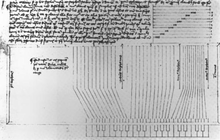Dulce melos

The dulce melos (or doucemelle) is an early keyboard instrument and possible ancestor of the piano. The instrument is described as a type of zither, similar to a hammered dulcimer, but with the strings struck by hammers on keys. The instrument had twelve pairs of strings, each divided into three sections in a 4:2:1 ratio, resulting in a full chromatic octave of 36 notes, as each note is divided into two higher octaves by the bridges. Among the instrument's first attestations was a 1440 work by Henri-Arnault de Zwolle.[1][2][3]
The instrument was researched in the 1844 publication Dissertation sur les instruments de musique au moyen-age by Bottée de Toulmon, which detailed a piano-like instrument detailed in a 15th-century Latin manuscript.[1]
References
- 1 2 Curt Sachs (19 September 2012). The History of Musical Instruments. Courier Corporation. pp. 343–. ISBN 978-0-486-17151-7.
- ↑ Igor Kipnis (15 April 2013). Harpsichord and Clavichord: An Encyclopedia. Routledge. pp. 158–. ISBN 978-1-135-94978-5.
- ↑ Early Keyboard Instruments. Norton. 1989. pp. 191–. ISBN 978-0-393-30515-9.
Further reading
- Stewart Pollens (1995). The Early Pianoforte. Cambridge University Press. pp. 25–. ISBN 978-0-521-41729-7.